Analyzing Racism in Australia: Upstream Factors & Karen Refugee Health
VerifiedAdded on 2023/06/11
|16
|4857
|483
Essay
AI Summary
This essay delves into the pervasive issue of racism in Australia, focusing specifically on the experiences of Karen refugees who have resettled in the country. It examines racism through the lens of upstream, midstream, and downstream determinants of health, categorizing these as macro, intermediate, and micro factors respectively. The essay explores how racism acts as a social determinant of health inequalities, impacting access to housing, employment, and healthcare services. It discusses the psychosocial stressors faced by Karen refugees, including social exclusion, discrimination, and the challenges of adapting to a new culture, which contribute to mental health issues and unhealthy coping mechanisms. Furthermore, the essay analyzes the physiological effects of chronic stress caused by racism, leading to increased morbidity and mortality rates among this population. Finally, it reviews the initiatives taken by the Australian government to address racism and support refugee resettlement, while also highlighting the need for further recommendations to improve the well-being of Karen refugees. Desklib offers similar essays and study resources for students.
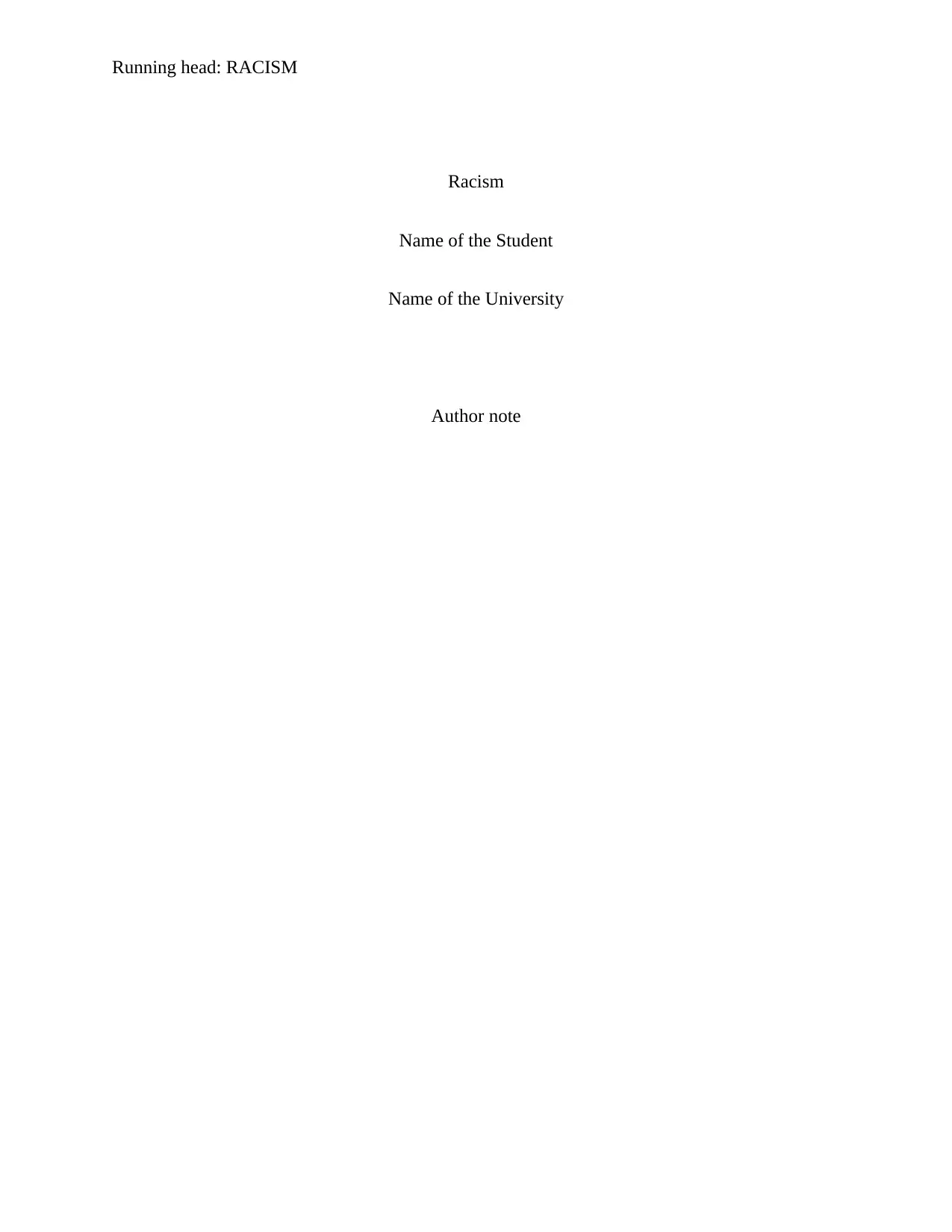
Running head: RACISM
Racism
Name of the Student
Name of the University
Author note
Racism
Name of the Student
Name of the University
Author note
Paraphrase This Document
Need a fresh take? Get an instant paraphrase of this document with our AI Paraphraser
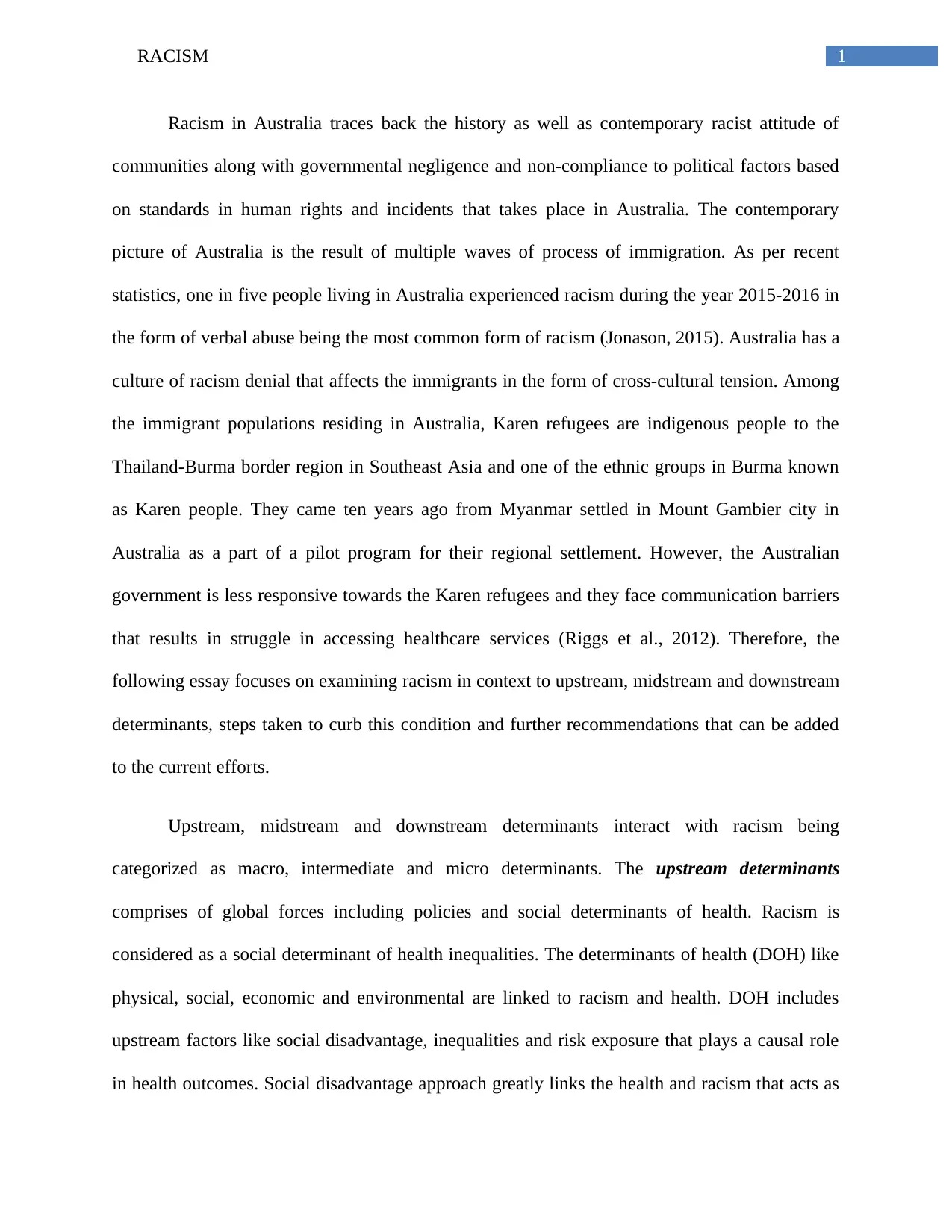
1RACISM
Racism in Australia traces back the history as well as contemporary racist attitude of
communities along with governmental negligence and non-compliance to political factors based
on standards in human rights and incidents that takes place in Australia. The contemporary
picture of Australia is the result of multiple waves of process of immigration. As per recent
statistics, one in five people living in Australia experienced racism during the year 2015-2016 in
the form of verbal abuse being the most common form of racism (Jonason, 2015). Australia has a
culture of racism denial that affects the immigrants in the form of cross-cultural tension. Among
the immigrant populations residing in Australia, Karen refugees are indigenous people to the
Thailand-Burma border region in Southeast Asia and one of the ethnic groups in Burma known
as Karen people. They came ten years ago from Myanmar settled in Mount Gambier city in
Australia as a part of a pilot program for their regional settlement. However, the Australian
government is less responsive towards the Karen refugees and they face communication barriers
that results in struggle in accessing healthcare services (Riggs et al., 2012). Therefore, the
following essay focuses on examining racism in context to upstream, midstream and downstream
determinants, steps taken to curb this condition and further recommendations that can be added
to the current efforts.
Upstream, midstream and downstream determinants interact with racism being
categorized as macro, intermediate and micro determinants. The upstream determinants
comprises of global forces including policies and social determinants of health. Racism is
considered as a social determinant of health inequalities. The determinants of health (DOH) like
physical, social, economic and environmental are linked to racism and health. DOH includes
upstream factors like social disadvantage, inequalities and risk exposure that plays a causal role
in health outcomes. Social disadvantage approach greatly links the health and racism that acts as
Racism in Australia traces back the history as well as contemporary racist attitude of
communities along with governmental negligence and non-compliance to political factors based
on standards in human rights and incidents that takes place in Australia. The contemporary
picture of Australia is the result of multiple waves of process of immigration. As per recent
statistics, one in five people living in Australia experienced racism during the year 2015-2016 in
the form of verbal abuse being the most common form of racism (Jonason, 2015). Australia has a
culture of racism denial that affects the immigrants in the form of cross-cultural tension. Among
the immigrant populations residing in Australia, Karen refugees are indigenous people to the
Thailand-Burma border region in Southeast Asia and one of the ethnic groups in Burma known
as Karen people. They came ten years ago from Myanmar settled in Mount Gambier city in
Australia as a part of a pilot program for their regional settlement. However, the Australian
government is less responsive towards the Karen refugees and they face communication barriers
that results in struggle in accessing healthcare services (Riggs et al., 2012). Therefore, the
following essay focuses on examining racism in context to upstream, midstream and downstream
determinants, steps taken to curb this condition and further recommendations that can be added
to the current efforts.
Upstream, midstream and downstream determinants interact with racism being
categorized as macro, intermediate and micro determinants. The upstream determinants
comprises of global forces including policies and social determinants of health. Racism is
considered as a social determinant of health inequalities. The determinants of health (DOH) like
physical, social, economic and environmental are linked to racism and health. DOH includes
upstream factors like social disadvantage, inequalities and risk exposure that plays a causal role
in health outcomes. Social disadvantage approach greatly links the health and racism that acts as
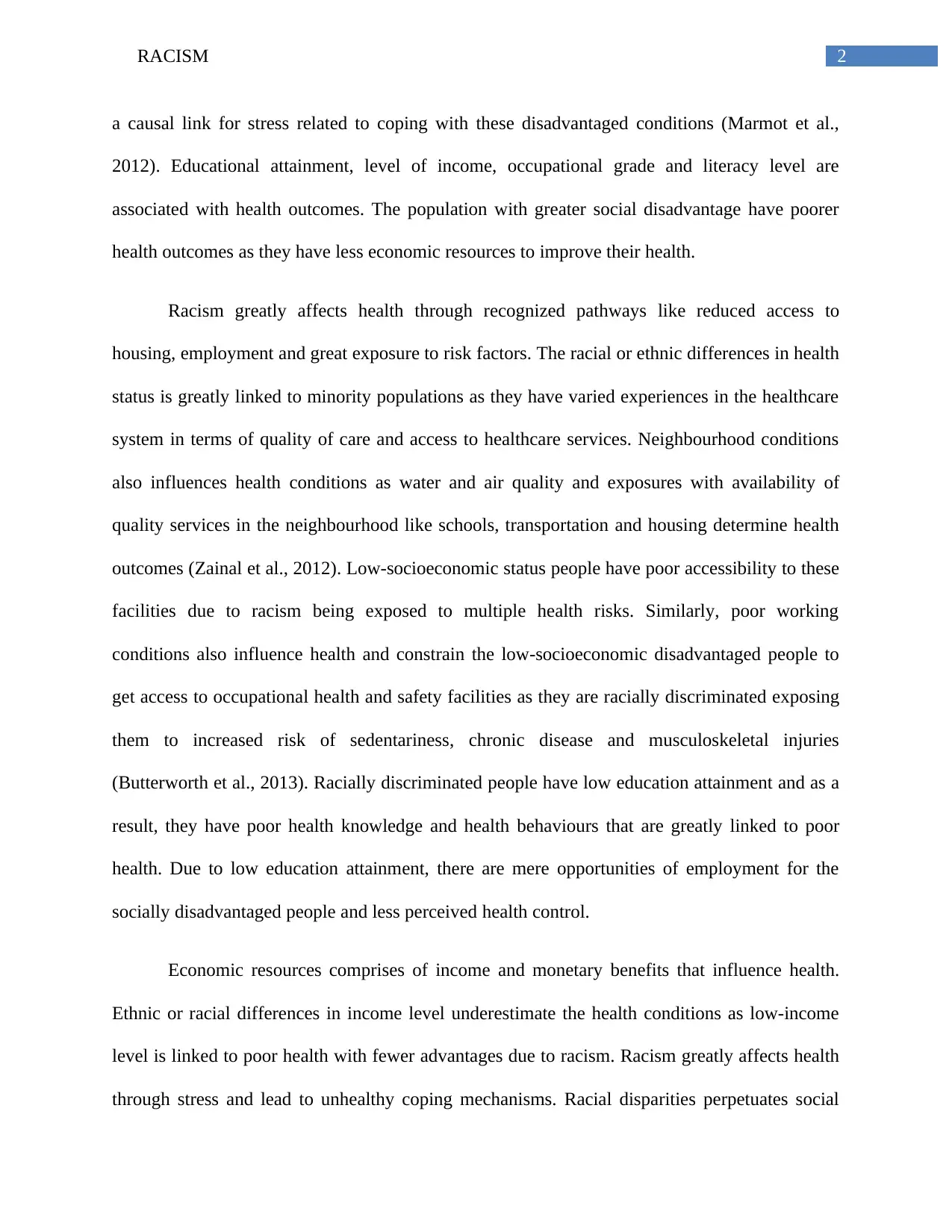
2RACISM
a causal link for stress related to coping with these disadvantaged conditions (Marmot et al.,
2012). Educational attainment, level of income, occupational grade and literacy level are
associated with health outcomes. The population with greater social disadvantage have poorer
health outcomes as they have less economic resources to improve their health.
Racism greatly affects health through recognized pathways like reduced access to
housing, employment and great exposure to risk factors. The racial or ethnic differences in health
status is greatly linked to minority populations as they have varied experiences in the healthcare
system in terms of quality of care and access to healthcare services. Neighbourhood conditions
also influences health conditions as water and air quality and exposures with availability of
quality services in the neighbourhood like schools, transportation and housing determine health
outcomes (Zainal et al., 2012). Low-socioeconomic status people have poor accessibility to these
facilities due to racism being exposed to multiple health risks. Similarly, poor working
conditions also influence health and constrain the low-socioeconomic disadvantaged people to
get access to occupational health and safety facilities as they are racially discriminated exposing
them to increased risk of sedentariness, chronic disease and musculoskeletal injuries
(Butterworth et al., 2013). Racially discriminated people have low education attainment and as a
result, they have poor health knowledge and health behaviours that are greatly linked to poor
health. Due to low education attainment, there are mere opportunities of employment for the
socially disadvantaged people and less perceived health control.
Economic resources comprises of income and monetary benefits that influence health.
Ethnic or racial differences in income level underestimate the health conditions as low-income
level is linked to poor health with fewer advantages due to racism. Racism greatly affects health
through stress and lead to unhealthy coping mechanisms. Racial disparities perpetuates social
a causal link for stress related to coping with these disadvantaged conditions (Marmot et al.,
2012). Educational attainment, level of income, occupational grade and literacy level are
associated with health outcomes. The population with greater social disadvantage have poorer
health outcomes as they have less economic resources to improve their health.
Racism greatly affects health through recognized pathways like reduced access to
housing, employment and great exposure to risk factors. The racial or ethnic differences in health
status is greatly linked to minority populations as they have varied experiences in the healthcare
system in terms of quality of care and access to healthcare services. Neighbourhood conditions
also influences health conditions as water and air quality and exposures with availability of
quality services in the neighbourhood like schools, transportation and housing determine health
outcomes (Zainal et al., 2012). Low-socioeconomic status people have poor accessibility to these
facilities due to racism being exposed to multiple health risks. Similarly, poor working
conditions also influence health and constrain the low-socioeconomic disadvantaged people to
get access to occupational health and safety facilities as they are racially discriminated exposing
them to increased risk of sedentariness, chronic disease and musculoskeletal injuries
(Butterworth et al., 2013). Racially discriminated people have low education attainment and as a
result, they have poor health knowledge and health behaviours that are greatly linked to poor
health. Due to low education attainment, there are mere opportunities of employment for the
socially disadvantaged people and less perceived health control.
Economic resources comprises of income and monetary benefits that influence health.
Ethnic or racial differences in income level underestimate the health conditions as low-income
level is linked to poor health with fewer advantages due to racism. Racism greatly affects health
through stress and lead to unhealthy coping mechanisms. Racial disparities perpetuates social
⊘ This is a preview!⊘
Do you want full access?
Subscribe today to unlock all pages.

Trusted by 1+ million students worldwide
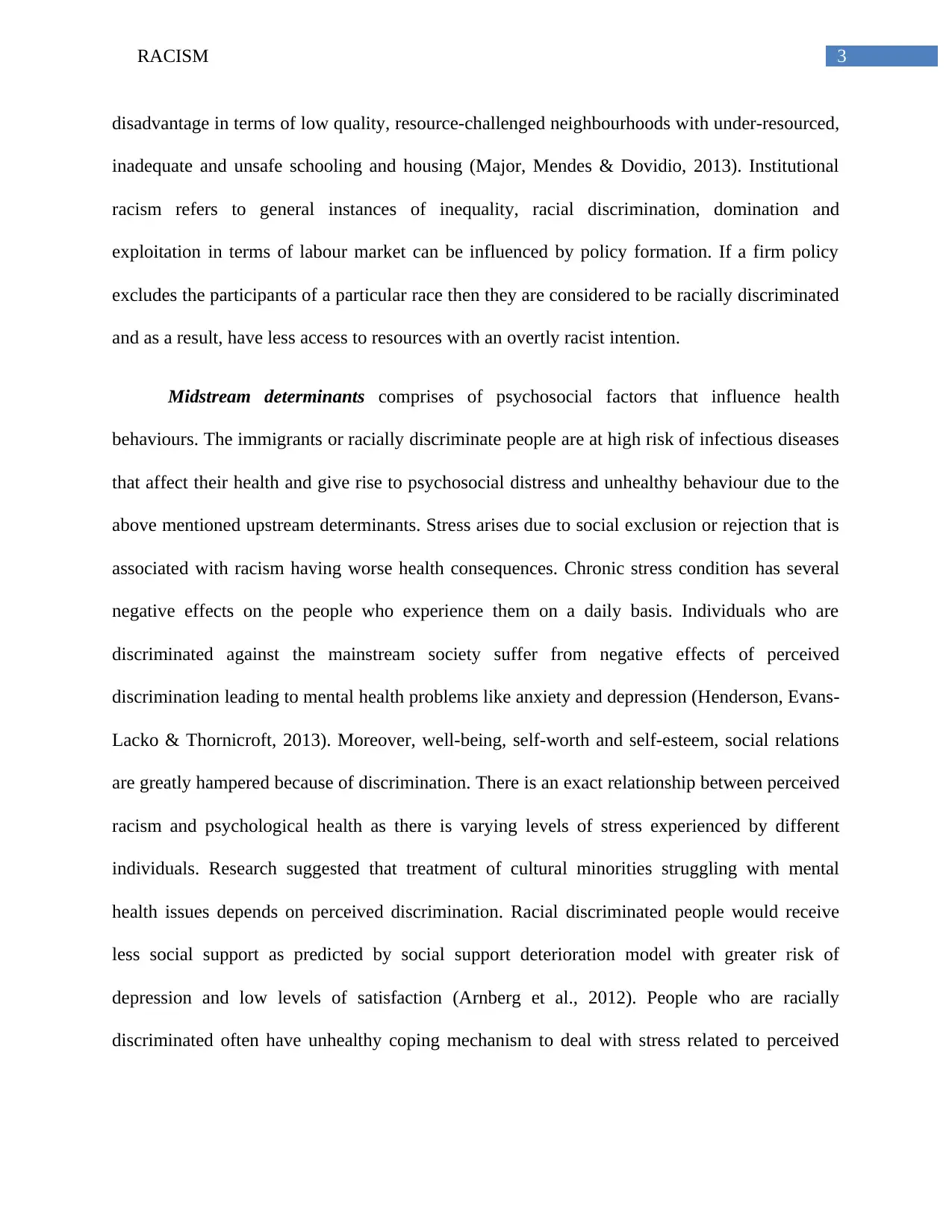
3RACISM
disadvantage in terms of low quality, resource-challenged neighbourhoods with under-resourced,
inadequate and unsafe schooling and housing (Major, Mendes & Dovidio, 2013). Institutional
racism refers to general instances of inequality, racial discrimination, domination and
exploitation in terms of labour market can be influenced by policy formation. If a firm policy
excludes the participants of a particular race then they are considered to be racially discriminated
and as a result, have less access to resources with an overtly racist intention.
Midstream determinants comprises of psychosocial factors that influence health
behaviours. The immigrants or racially discriminate people are at high risk of infectious diseases
that affect their health and give rise to psychosocial distress and unhealthy behaviour due to the
above mentioned upstream determinants. Stress arises due to social exclusion or rejection that is
associated with racism having worse health consequences. Chronic stress condition has several
negative effects on the people who experience them on a daily basis. Individuals who are
discriminated against the mainstream society suffer from negative effects of perceived
discrimination leading to mental health problems like anxiety and depression (Henderson, Evans-
Lacko & Thornicroft, 2013). Moreover, well-being, self-worth and self-esteem, social relations
are greatly hampered because of discrimination. There is an exact relationship between perceived
racism and psychological health as there is varying levels of stress experienced by different
individuals. Research suggested that treatment of cultural minorities struggling with mental
health issues depends on perceived discrimination. Racial discriminated people would receive
less social support as predicted by social support deterioration model with greater risk of
depression and low levels of satisfaction (Arnberg et al., 2012). People who are racially
discriminated often have unhealthy coping mechanism to deal with stress related to perceived
disadvantage in terms of low quality, resource-challenged neighbourhoods with under-resourced,
inadequate and unsafe schooling and housing (Major, Mendes & Dovidio, 2013). Institutional
racism refers to general instances of inequality, racial discrimination, domination and
exploitation in terms of labour market can be influenced by policy formation. If a firm policy
excludes the participants of a particular race then they are considered to be racially discriminated
and as a result, have less access to resources with an overtly racist intention.
Midstream determinants comprises of psychosocial factors that influence health
behaviours. The immigrants or racially discriminate people are at high risk of infectious diseases
that affect their health and give rise to psychosocial distress and unhealthy behaviour due to the
above mentioned upstream determinants. Stress arises due to social exclusion or rejection that is
associated with racism having worse health consequences. Chronic stress condition has several
negative effects on the people who experience them on a daily basis. Individuals who are
discriminated against the mainstream society suffer from negative effects of perceived
discrimination leading to mental health problems like anxiety and depression (Henderson, Evans-
Lacko & Thornicroft, 2013). Moreover, well-being, self-worth and self-esteem, social relations
are greatly hampered because of discrimination. There is an exact relationship between perceived
racism and psychological health as there is varying levels of stress experienced by different
individuals. Research suggested that treatment of cultural minorities struggling with mental
health issues depends on perceived discrimination. Racial discriminated people would receive
less social support as predicted by social support deterioration model with greater risk of
depression and low levels of satisfaction (Arnberg et al., 2012). People who are racially
discriminated often have unhealthy coping mechanism to deal with stress related to perceived
Paraphrase This Document
Need a fresh take? Get an instant paraphrase of this document with our AI Paraphraser
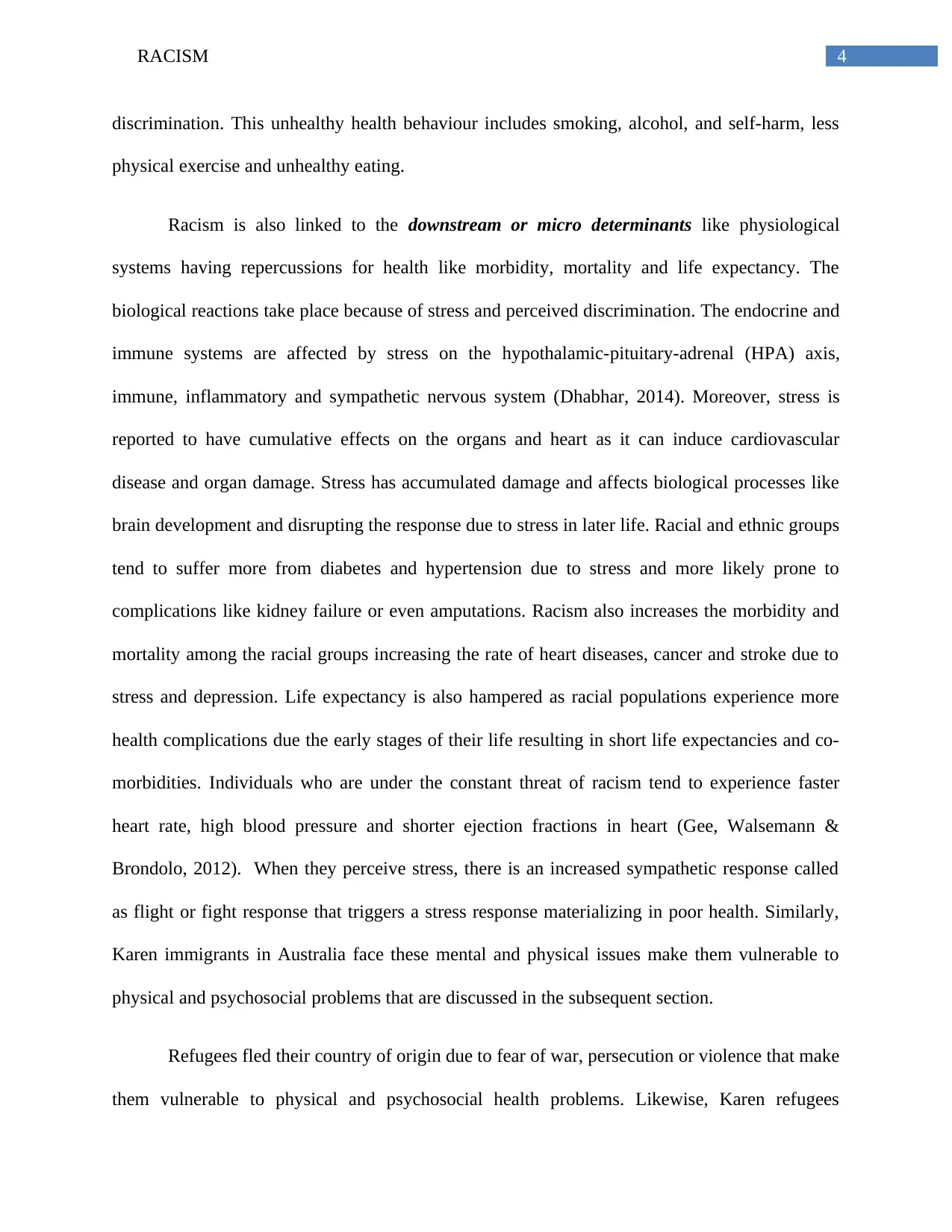
4RACISM
discrimination. This unhealthy health behaviour includes smoking, alcohol, and self-harm, less
physical exercise and unhealthy eating.
Racism is also linked to the downstream or micro determinants like physiological
systems having repercussions for health like morbidity, mortality and life expectancy. The
biological reactions take place because of stress and perceived discrimination. The endocrine and
immune systems are affected by stress on the hypothalamic-pituitary-adrenal (HPA) axis,
immune, inflammatory and sympathetic nervous system (Dhabhar, 2014). Moreover, stress is
reported to have cumulative effects on the organs and heart as it can induce cardiovascular
disease and organ damage. Stress has accumulated damage and affects biological processes like
brain development and disrupting the response due to stress in later life. Racial and ethnic groups
tend to suffer more from diabetes and hypertension due to stress and more likely prone to
complications like kidney failure or even amputations. Racism also increases the morbidity and
mortality among the racial groups increasing the rate of heart diseases, cancer and stroke due to
stress and depression. Life expectancy is also hampered as racial populations experience more
health complications due the early stages of their life resulting in short life expectancies and co-
morbidities. Individuals who are under the constant threat of racism tend to experience faster
heart rate, high blood pressure and shorter ejection fractions in heart (Gee, Walsemann &
Brondolo, 2012). When they perceive stress, there is an increased sympathetic response called
as flight or fight response that triggers a stress response materializing in poor health. Similarly,
Karen immigrants in Australia face these mental and physical issues make them vulnerable to
physical and psychosocial problems that are discussed in the subsequent section.
Refugees fled their country of origin due to fear of war, persecution or violence that make
them vulnerable to physical and psychosocial health problems. Likewise, Karen refugees
discrimination. This unhealthy health behaviour includes smoking, alcohol, and self-harm, less
physical exercise and unhealthy eating.
Racism is also linked to the downstream or micro determinants like physiological
systems having repercussions for health like morbidity, mortality and life expectancy. The
biological reactions take place because of stress and perceived discrimination. The endocrine and
immune systems are affected by stress on the hypothalamic-pituitary-adrenal (HPA) axis,
immune, inflammatory and sympathetic nervous system (Dhabhar, 2014). Moreover, stress is
reported to have cumulative effects on the organs and heart as it can induce cardiovascular
disease and organ damage. Stress has accumulated damage and affects biological processes like
brain development and disrupting the response due to stress in later life. Racial and ethnic groups
tend to suffer more from diabetes and hypertension due to stress and more likely prone to
complications like kidney failure or even amputations. Racism also increases the morbidity and
mortality among the racial groups increasing the rate of heart diseases, cancer and stroke due to
stress and depression. Life expectancy is also hampered as racial populations experience more
health complications due the early stages of their life resulting in short life expectancies and co-
morbidities. Individuals who are under the constant threat of racism tend to experience faster
heart rate, high blood pressure and shorter ejection fractions in heart (Gee, Walsemann &
Brondolo, 2012). When they perceive stress, there is an increased sympathetic response called
as flight or fight response that triggers a stress response materializing in poor health. Similarly,
Karen immigrants in Australia face these mental and physical issues make them vulnerable to
physical and psychosocial problems that are discussed in the subsequent section.
Refugees fled their country of origin due to fear of war, persecution or violence that make
them vulnerable to physical and psychosocial health problems. Likewise, Karen refugees
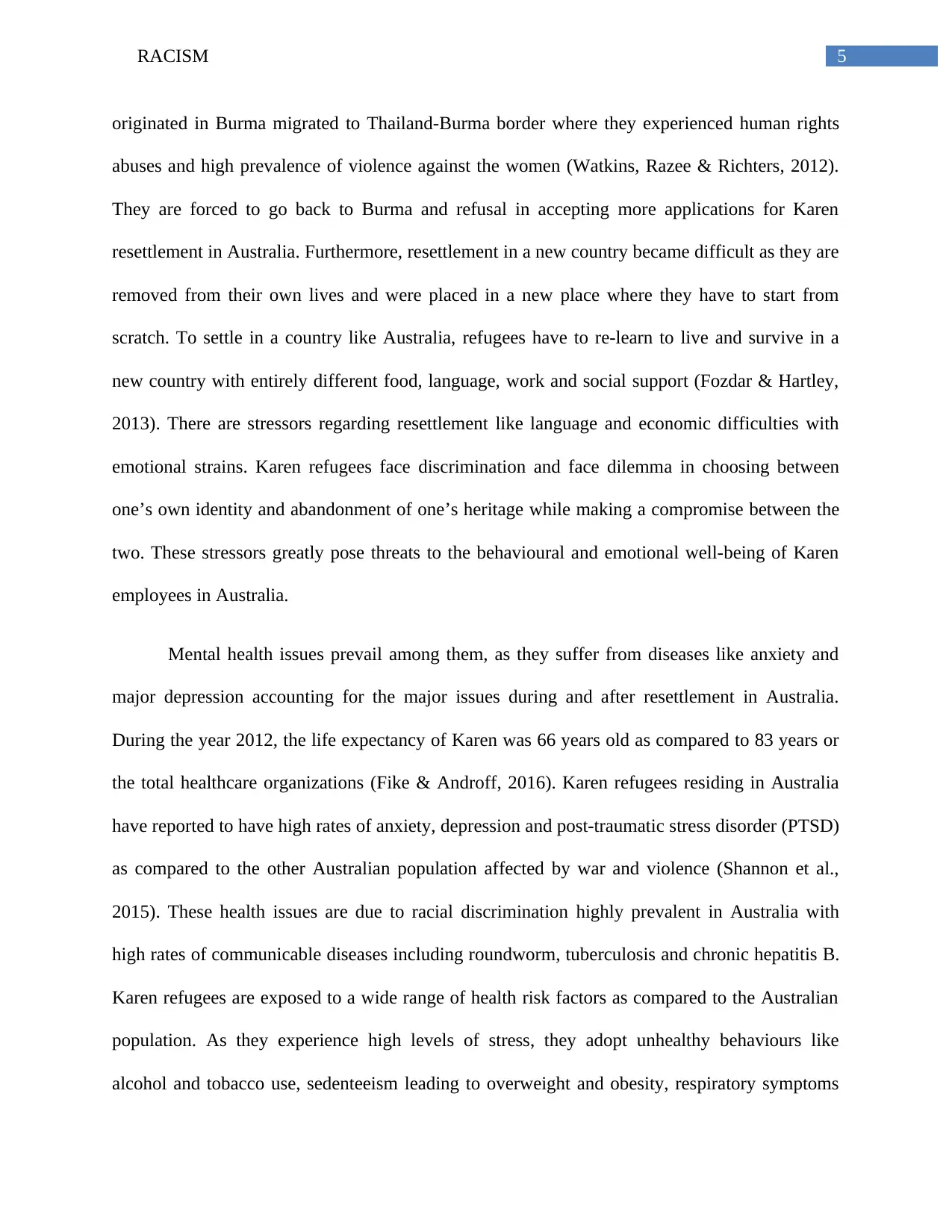
5RACISM
originated in Burma migrated to Thailand-Burma border where they experienced human rights
abuses and high prevalence of violence against the women (Watkins, Razee & Richters, 2012).
They are forced to go back to Burma and refusal in accepting more applications for Karen
resettlement in Australia. Furthermore, resettlement in a new country became difficult as they are
removed from their own lives and were placed in a new place where they have to start from
scratch. To settle in a country like Australia, refugees have to re-learn to live and survive in a
new country with entirely different food, language, work and social support (Fozdar & Hartley,
2013). There are stressors regarding resettlement like language and economic difficulties with
emotional strains. Karen refugees face discrimination and face dilemma in choosing between
one’s own identity and abandonment of one’s heritage while making a compromise between the
two. These stressors greatly pose threats to the behavioural and emotional well-being of Karen
employees in Australia.
Mental health issues prevail among them, as they suffer from diseases like anxiety and
major depression accounting for the major issues during and after resettlement in Australia.
During the year 2012, the life expectancy of Karen was 66 years old as compared to 83 years or
the total healthcare organizations (Fike & Androff, 2016). Karen refugees residing in Australia
have reported to have high rates of anxiety, depression and post-traumatic stress disorder (PTSD)
as compared to the other Australian population affected by war and violence (Shannon et al.,
2015). These health issues are due to racial discrimination highly prevalent in Australia with
high rates of communicable diseases including roundworm, tuberculosis and chronic hepatitis B.
Karen refugees are exposed to a wide range of health risk factors as compared to the Australian
population. As they experience high levels of stress, they adopt unhealthy behaviours like
alcohol and tobacco use, sedenteeism leading to overweight and obesity, respiratory symptoms
originated in Burma migrated to Thailand-Burma border where they experienced human rights
abuses and high prevalence of violence against the women (Watkins, Razee & Richters, 2012).
They are forced to go back to Burma and refusal in accepting more applications for Karen
resettlement in Australia. Furthermore, resettlement in a new country became difficult as they are
removed from their own lives and were placed in a new place where they have to start from
scratch. To settle in a country like Australia, refugees have to re-learn to live and survive in a
new country with entirely different food, language, work and social support (Fozdar & Hartley,
2013). There are stressors regarding resettlement like language and economic difficulties with
emotional strains. Karen refugees face discrimination and face dilemma in choosing between
one’s own identity and abandonment of one’s heritage while making a compromise between the
two. These stressors greatly pose threats to the behavioural and emotional well-being of Karen
employees in Australia.
Mental health issues prevail among them, as they suffer from diseases like anxiety and
major depression accounting for the major issues during and after resettlement in Australia.
During the year 2012, the life expectancy of Karen was 66 years old as compared to 83 years or
the total healthcare organizations (Fike & Androff, 2016). Karen refugees residing in Australia
have reported to have high rates of anxiety, depression and post-traumatic stress disorder (PTSD)
as compared to the other Australian population affected by war and violence (Shannon et al.,
2015). These health issues are due to racial discrimination highly prevalent in Australia with
high rates of communicable diseases including roundworm, tuberculosis and chronic hepatitis B.
Karen refugees are exposed to a wide range of health risk factors as compared to the Australian
population. As they experience high levels of stress, they adopt unhealthy behaviours like
alcohol and tobacco use, sedenteeism leading to overweight and obesity, respiratory symptoms
⊘ This is a preview!⊘
Do you want full access?
Subscribe today to unlock all pages.

Trusted by 1+ million students worldwide

6RACISM
and unhealthy lifestyle. The percentage of intense and moderate exercise was found to be low as
the refugees reported to have long hours of sitting. As they are discriminated or marginalized,
they are less likely to seek education, training and health information especially older people in
Karen population. There were no medical staffs to provide help with health education (Riggs et
al., 2012).
In Australia, Burmese women are subjected to abuse due to absence of legal status,
labour protections, denial of healthcare services and prevailing harsh environments. The racially
discriminated group, Karen population has life expectancy of 64.5 years as compared to the
people residing in Australia with 81.7 years (Pratt & Loff, 2014). Vitamin D deficiency,
Helicobacter pylori infections and strongyloidiasis are highly prevalent among Karen refugees in
Australia due to poor access to healthcare services. Karen refugees are unable to cope up, adjust
to the current racial situation, and experience physical and psychosocial trauma that give them a
sense of powerlessness, low self-esteem and control. Moreover, they faced challenges in
resettlement where the process was decentralized and local agencies operated it with inadequate
human resources and finances. There are cited barriers like inaccessible education, inadequate
shelter, healthcare and employment where refugees are concentrated in low-income and low-rent
apartments exposing them to overcrowding, violence and housing in a state of disrepair (Soldatic
et al., 2017). Children take admissions in struggling schools with limited resources and as a
result, they are unable to integrate into the mainstream and seek employment in the future.
Therefore, there is a need to look into the policies and programs that have been developed by
Australian government in addressing the above racism issue faced by Karen employees.
In the last three decades, Australian government has taken initiatives that are helpful for
the Karen refugees to taken an active part in resettlement and overcome perceived barriers.
and unhealthy lifestyle. The percentage of intense and moderate exercise was found to be low as
the refugees reported to have long hours of sitting. As they are discriminated or marginalized,
they are less likely to seek education, training and health information especially older people in
Karen population. There were no medical staffs to provide help with health education (Riggs et
al., 2012).
In Australia, Burmese women are subjected to abuse due to absence of legal status,
labour protections, denial of healthcare services and prevailing harsh environments. The racially
discriminated group, Karen population has life expectancy of 64.5 years as compared to the
people residing in Australia with 81.7 years (Pratt & Loff, 2014). Vitamin D deficiency,
Helicobacter pylori infections and strongyloidiasis are highly prevalent among Karen refugees in
Australia due to poor access to healthcare services. Karen refugees are unable to cope up, adjust
to the current racial situation, and experience physical and psychosocial trauma that give them a
sense of powerlessness, low self-esteem and control. Moreover, they faced challenges in
resettlement where the process was decentralized and local agencies operated it with inadequate
human resources and finances. There are cited barriers like inaccessible education, inadequate
shelter, healthcare and employment where refugees are concentrated in low-income and low-rent
apartments exposing them to overcrowding, violence and housing in a state of disrepair (Soldatic
et al., 2017). Children take admissions in struggling schools with limited resources and as a
result, they are unable to integrate into the mainstream and seek employment in the future.
Therefore, there is a need to look into the policies and programs that have been developed by
Australian government in addressing the above racism issue faced by Karen employees.
In the last three decades, Australian government has taken initiatives that are helpful for
the Karen refugees to taken an active part in resettlement and overcome perceived barriers.
Paraphrase This Document
Need a fresh take? Get an instant paraphrase of this document with our AI Paraphraser
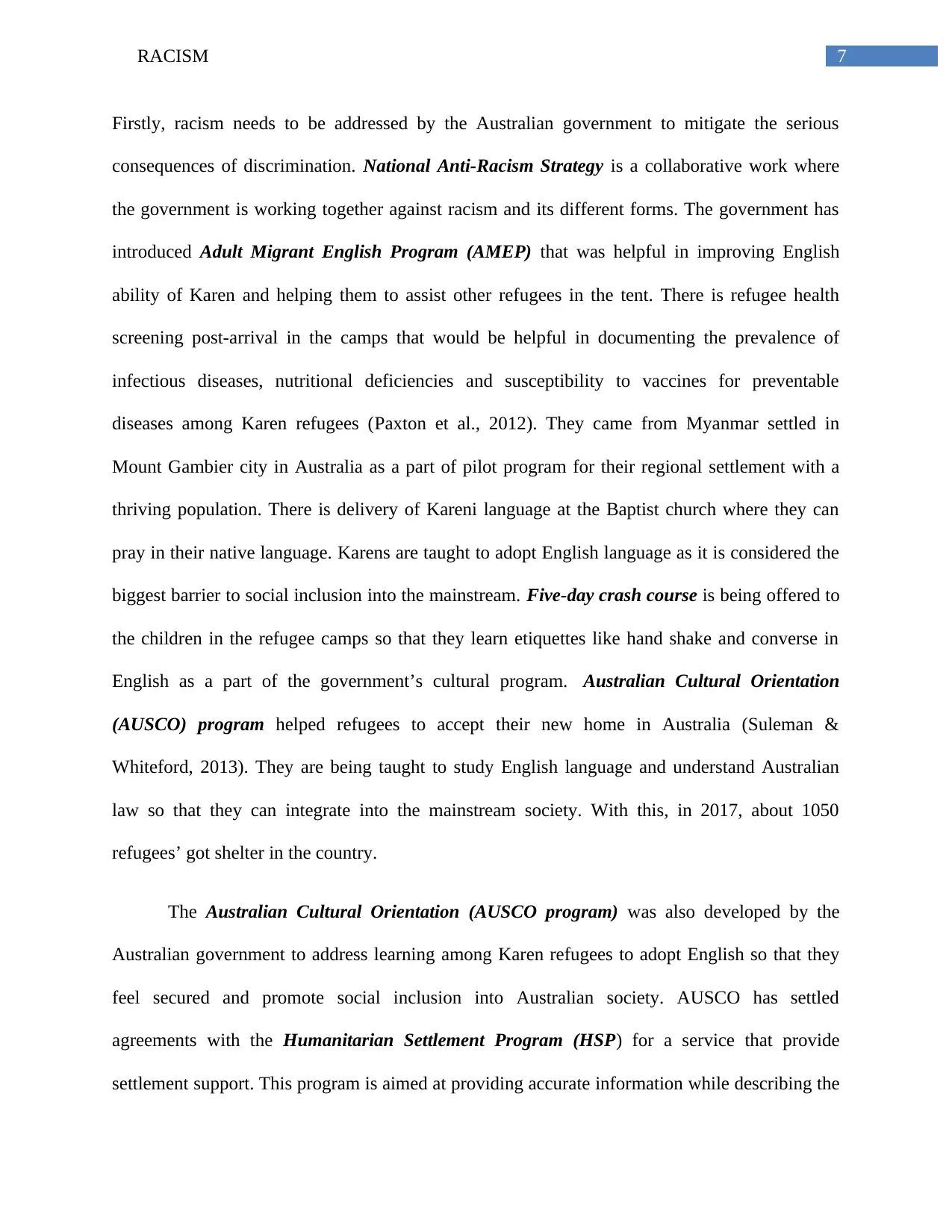
7RACISM
Firstly, racism needs to be addressed by the Australian government to mitigate the serious
consequences of discrimination. National Anti-Racism Strategy is a collaborative work where
the government is working together against racism and its different forms. The government has
introduced Adult Migrant English Program (AMEP) that was helpful in improving English
ability of Karen and helping them to assist other refugees in the tent. There is refugee health
screening post-arrival in the camps that would be helpful in documenting the prevalence of
infectious diseases, nutritional deficiencies and susceptibility to vaccines for preventable
diseases among Karen refugees (Paxton et al., 2012). They came from Myanmar settled in
Mount Gambier city in Australia as a part of pilot program for their regional settlement with a
thriving population. There is delivery of Kareni language at the Baptist church where they can
pray in their native language. Karens are taught to adopt English language as it is considered the
biggest barrier to social inclusion into the mainstream. Five-day crash course is being offered to
the children in the refugee camps so that they learn etiquettes like hand shake and converse in
English as a part of the government’s cultural program. Australian Cultural Orientation
(AUSCO) program helped refugees to accept their new home in Australia (Suleman &
Whiteford, 2013). They are being taught to study English language and understand Australian
law so that they can integrate into the mainstream society. With this, in 2017, about 1050
refugees’ got shelter in the country.
The Australian Cultural Orientation (AUSCO program) was also developed by the
Australian government to address learning among Karen refugees to adopt English so that they
feel secured and promote social inclusion into Australian society. AUSCO has settled
agreements with the Humanitarian Settlement Program (HSP) for a service that provide
settlement support. This program is aimed at providing accurate information while describing the
Firstly, racism needs to be addressed by the Australian government to mitigate the serious
consequences of discrimination. National Anti-Racism Strategy is a collaborative work where
the government is working together against racism and its different forms. The government has
introduced Adult Migrant English Program (AMEP) that was helpful in improving English
ability of Karen and helping them to assist other refugees in the tent. There is refugee health
screening post-arrival in the camps that would be helpful in documenting the prevalence of
infectious diseases, nutritional deficiencies and susceptibility to vaccines for preventable
diseases among Karen refugees (Paxton et al., 2012). They came from Myanmar settled in
Mount Gambier city in Australia as a part of pilot program for their regional settlement with a
thriving population. There is delivery of Kareni language at the Baptist church where they can
pray in their native language. Karens are taught to adopt English language as it is considered the
biggest barrier to social inclusion into the mainstream. Five-day crash course is being offered to
the children in the refugee camps so that they learn etiquettes like hand shake and converse in
English as a part of the government’s cultural program. Australian Cultural Orientation
(AUSCO) program helped refugees to accept their new home in Australia (Suleman &
Whiteford, 2013). They are being taught to study English language and understand Australian
law so that they can integrate into the mainstream society. With this, in 2017, about 1050
refugees’ got shelter in the country.
The Australian Cultural Orientation (AUSCO program) was also developed by the
Australian government to address learning among Karen refugees to adopt English so that they
feel secured and promote social inclusion into Australian society. AUSCO has settled
agreements with the Humanitarian Settlement Program (HSP) for a service that provide
settlement support. This program is aimed at providing accurate information while describing the

8RACISM
settlement process in Australia. There is empowerment of people by encouraging them to learn
English language post-arrival for social inclusion. The participants are given basic skills that are
required for self-sufficiency achievement. Moreover, the participants are equipped with
necessary tools that can deal with settlement concerns in context to social, cultural and economic
adaptation under laws and norms (Suleman & Whiteford, 2013). Various types of teaching
methods have also been adopted by the program throughout the course like use of case studies,
brainstorming simulations, role-play activities, problem solving and discussions. Australia’s
Refugee and Humanitarian Program, 2018-2019 has two major parts: resettlement program and
people protection who claim asylums. The resettlement program helps to resettle the immigrants
and refugees who came from outside Australia. Another program is organized on the Thai-
Burma border called ACU Refugee Program that provided with the policies, practices and
investigation of experiences of Karen refugees resettled in Australia and Canada. The program is
aimed at welcoming the Karen refugees in the new world of Australia (Hoang, 2017).
The Australian government is currently operating various campaigns. The Refugee
Council of Australia is aimed at leveraging off work to date ensuring that Australian policies
towards asylum seeking and refugees get right to protection. The government want to ensure that
the policies reflect decency, respect and traditional generosity to the refugees while make
advancements in the national and international standing interests in Australia. In April 2018, new
initiatives were introduced in the Australian community in welcoming refugees with a positive
spirit. Community Refugee Sponsorship Initiative (CRSI) is aimed at creating a system that
would allow generosity of ordinary population to flourish. This program would make an extra
effort in effective partnership in order to welcome and support the displaced people in this
population. Australia’s settlement services for refugees and immigrants are aimed at assisting
settlement process in Australia. There is empowerment of people by encouraging them to learn
English language post-arrival for social inclusion. The participants are given basic skills that are
required for self-sufficiency achievement. Moreover, the participants are equipped with
necessary tools that can deal with settlement concerns in context to social, cultural and economic
adaptation under laws and norms (Suleman & Whiteford, 2013). Various types of teaching
methods have also been adopted by the program throughout the course like use of case studies,
brainstorming simulations, role-play activities, problem solving and discussions. Australia’s
Refugee and Humanitarian Program, 2018-2019 has two major parts: resettlement program and
people protection who claim asylums. The resettlement program helps to resettle the immigrants
and refugees who came from outside Australia. Another program is organized on the Thai-
Burma border called ACU Refugee Program that provided with the policies, practices and
investigation of experiences of Karen refugees resettled in Australia and Canada. The program is
aimed at welcoming the Karen refugees in the new world of Australia (Hoang, 2017).
The Australian government is currently operating various campaigns. The Refugee
Council of Australia is aimed at leveraging off work to date ensuring that Australian policies
towards asylum seeking and refugees get right to protection. The government want to ensure that
the policies reflect decency, respect and traditional generosity to the refugees while make
advancements in the national and international standing interests in Australia. In April 2018, new
initiatives were introduced in the Australian community in welcoming refugees with a positive
spirit. Community Refugee Sponsorship Initiative (CRSI) is aimed at creating a system that
would allow generosity of ordinary population to flourish. This program would make an extra
effort in effective partnership in order to welcome and support the displaced people in this
population. Australia’s settlement services for refugees and immigrants are aimed at assisting
⊘ This is a preview!⊘
Do you want full access?
Subscribe today to unlock all pages.

Trusted by 1+ million students worldwide
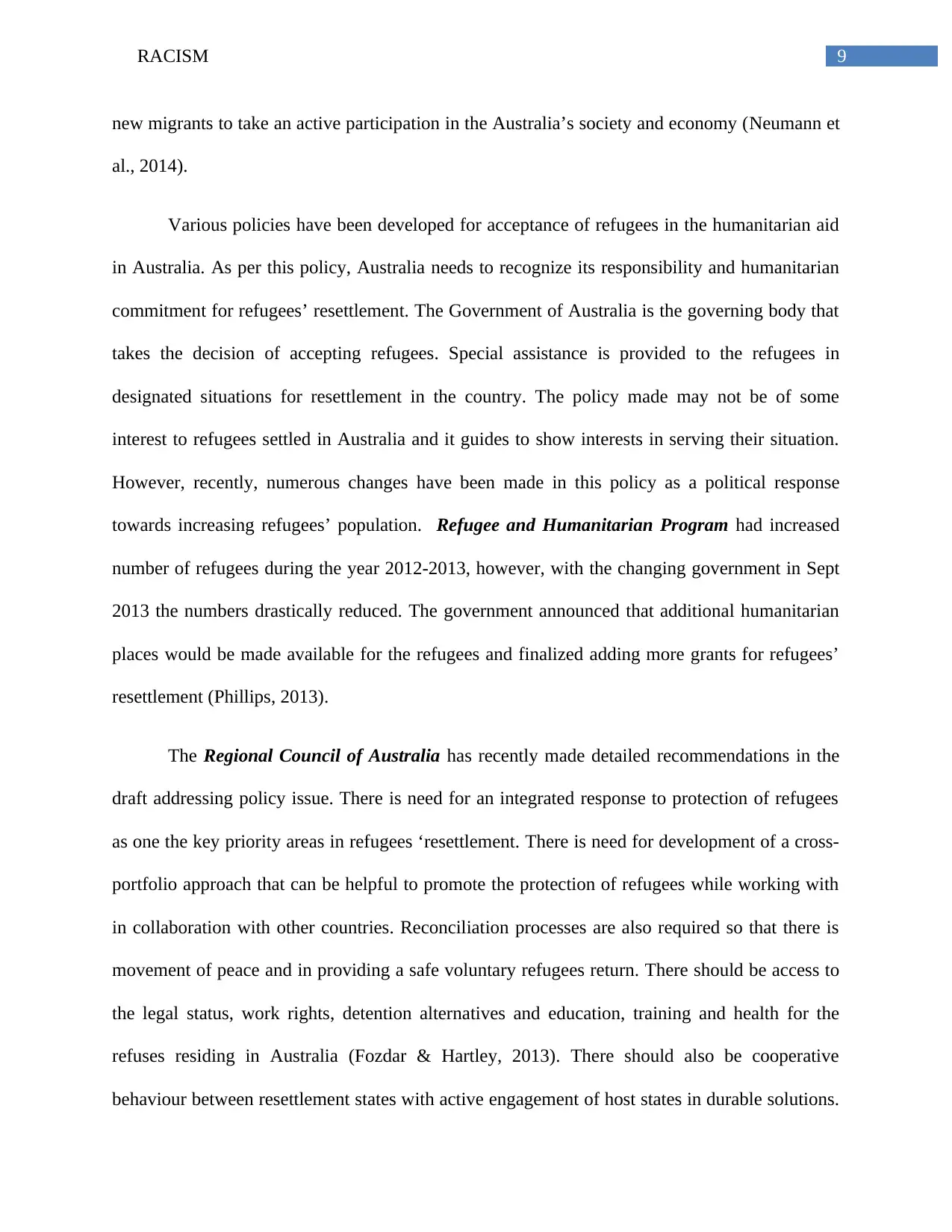
9RACISM
new migrants to take an active participation in the Australia’s society and economy (Neumann et
al., 2014).
Various policies have been developed for acceptance of refugees in the humanitarian aid
in Australia. As per this policy, Australia needs to recognize its responsibility and humanitarian
commitment for refugees’ resettlement. The Government of Australia is the governing body that
takes the decision of accepting refugees. Special assistance is provided to the refugees in
designated situations for resettlement in the country. The policy made may not be of some
interest to refugees settled in Australia and it guides to show interests in serving their situation.
However, recently, numerous changes have been made in this policy as a political response
towards increasing refugees’ population. Refugee and Humanitarian Program had increased
number of refugees during the year 2012-2013, however, with the changing government in Sept
2013 the numbers drastically reduced. The government announced that additional humanitarian
places would be made available for the refugees and finalized adding more grants for refugees’
resettlement (Phillips, 2013).
The Regional Council of Australia has recently made detailed recommendations in the
draft addressing policy issue. There is need for an integrated response to protection of refugees
as one the key priority areas in refugees ‘resettlement. There is need for development of a cross-
portfolio approach that can be helpful to promote the protection of refugees while working with
in collaboration with other countries. Reconciliation processes are also required so that there is
movement of peace and in providing a safe voluntary refugees return. There should be access to
the legal status, work rights, detention alternatives and education, training and health for the
refuses residing in Australia (Fozdar & Hartley, 2013). There should also be cooperative
behaviour between resettlement states with active engagement of host states in durable solutions.
new migrants to take an active participation in the Australia’s society and economy (Neumann et
al., 2014).
Various policies have been developed for acceptance of refugees in the humanitarian aid
in Australia. As per this policy, Australia needs to recognize its responsibility and humanitarian
commitment for refugees’ resettlement. The Government of Australia is the governing body that
takes the decision of accepting refugees. Special assistance is provided to the refugees in
designated situations for resettlement in the country. The policy made may not be of some
interest to refugees settled in Australia and it guides to show interests in serving their situation.
However, recently, numerous changes have been made in this policy as a political response
towards increasing refugees’ population. Refugee and Humanitarian Program had increased
number of refugees during the year 2012-2013, however, with the changing government in Sept
2013 the numbers drastically reduced. The government announced that additional humanitarian
places would be made available for the refugees and finalized adding more grants for refugees’
resettlement (Phillips, 2013).
The Regional Council of Australia has recently made detailed recommendations in the
draft addressing policy issue. There is need for an integrated response to protection of refugees
as one the key priority areas in refugees ‘resettlement. There is need for development of a cross-
portfolio approach that can be helpful to promote the protection of refugees while working with
in collaboration with other countries. Reconciliation processes are also required so that there is
movement of peace and in providing a safe voluntary refugees return. There should be access to
the legal status, work rights, detention alternatives and education, training and health for the
refuses residing in Australia (Fozdar & Hartley, 2013). There should also be cooperative
behaviour between resettlement states with active engagement of host states in durable solutions.
Paraphrase This Document
Need a fresh take? Get an instant paraphrase of this document with our AI Paraphraser
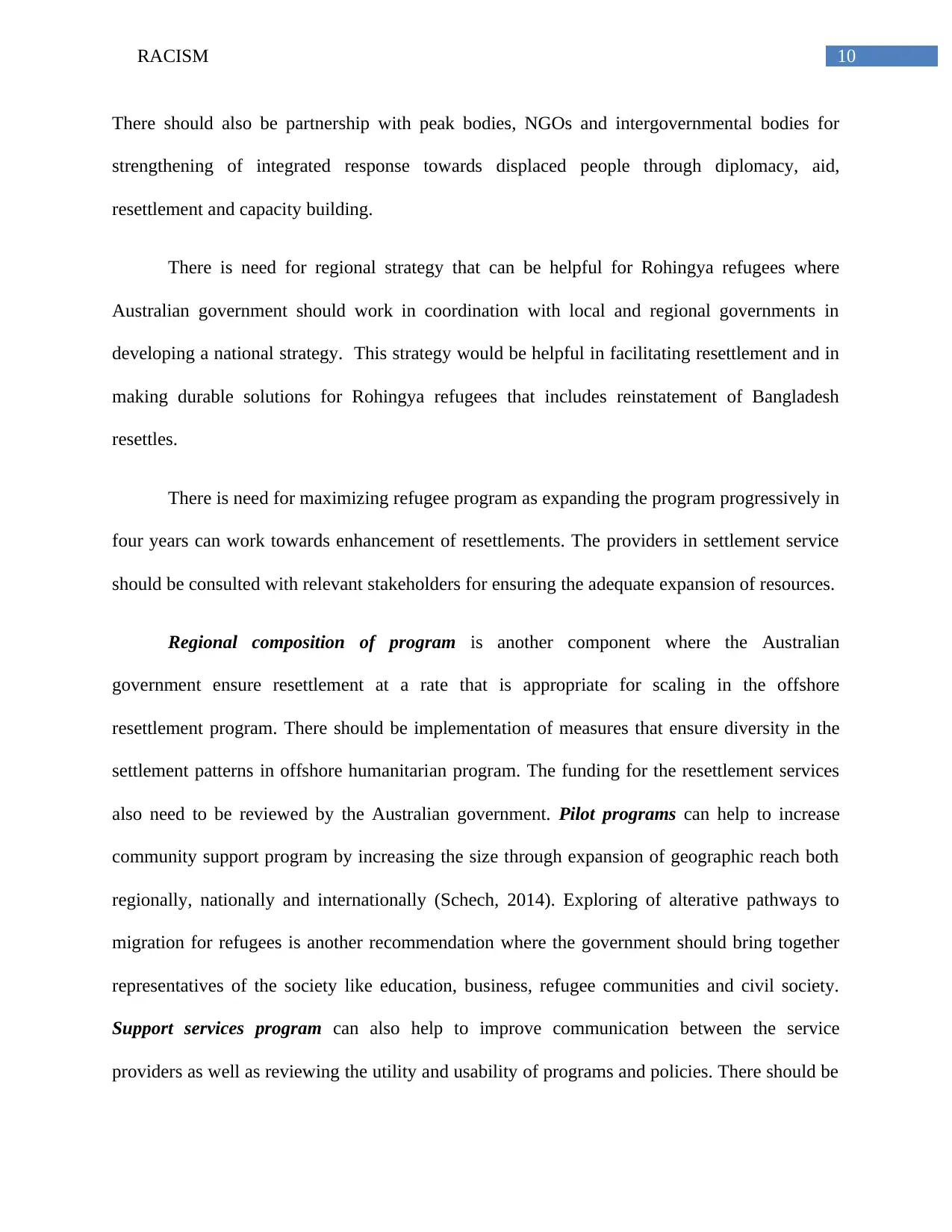
10RACISM
There should also be partnership with peak bodies, NGOs and intergovernmental bodies for
strengthening of integrated response towards displaced people through diplomacy, aid,
resettlement and capacity building.
There is need for regional strategy that can be helpful for Rohingya refugees where
Australian government should work in coordination with local and regional governments in
developing a national strategy. This strategy would be helpful in facilitating resettlement and in
making durable solutions for Rohingya refugees that includes reinstatement of Bangladesh
resettles.
There is need for maximizing refugee program as expanding the program progressively in
four years can work towards enhancement of resettlements. The providers in settlement service
should be consulted with relevant stakeholders for ensuring the adequate expansion of resources.
Regional composition of program is another component where the Australian
government ensure resettlement at a rate that is appropriate for scaling in the offshore
resettlement program. There should be implementation of measures that ensure diversity in the
settlement patterns in offshore humanitarian program. The funding for the resettlement services
also need to be reviewed by the Australian government. Pilot programs can help to increase
community support program by increasing the size through expansion of geographic reach both
regionally, nationally and internationally (Schech, 2014). Exploring of alterative pathways to
migration for refugees is another recommendation where the government should bring together
representatives of the society like education, business, refugee communities and civil society.
Support services program can also help to improve communication between the service
providers as well as reviewing the utility and usability of programs and policies. There should be
There should also be partnership with peak bodies, NGOs and intergovernmental bodies for
strengthening of integrated response towards displaced people through diplomacy, aid,
resettlement and capacity building.
There is need for regional strategy that can be helpful for Rohingya refugees where
Australian government should work in coordination with local and regional governments in
developing a national strategy. This strategy would be helpful in facilitating resettlement and in
making durable solutions for Rohingya refugees that includes reinstatement of Bangladesh
resettles.
There is need for maximizing refugee program as expanding the program progressively in
four years can work towards enhancement of resettlements. The providers in settlement service
should be consulted with relevant stakeholders for ensuring the adequate expansion of resources.
Regional composition of program is another component where the Australian
government ensure resettlement at a rate that is appropriate for scaling in the offshore
resettlement program. There should be implementation of measures that ensure diversity in the
settlement patterns in offshore humanitarian program. The funding for the resettlement services
also need to be reviewed by the Australian government. Pilot programs can help to increase
community support program by increasing the size through expansion of geographic reach both
regionally, nationally and internationally (Schech, 2014). Exploring of alterative pathways to
migration for refugees is another recommendation where the government should bring together
representatives of the society like education, business, refugee communities and civil society.
Support services program can also help to improve communication between the service
providers as well as reviewing the utility and usability of programs and policies. There should be
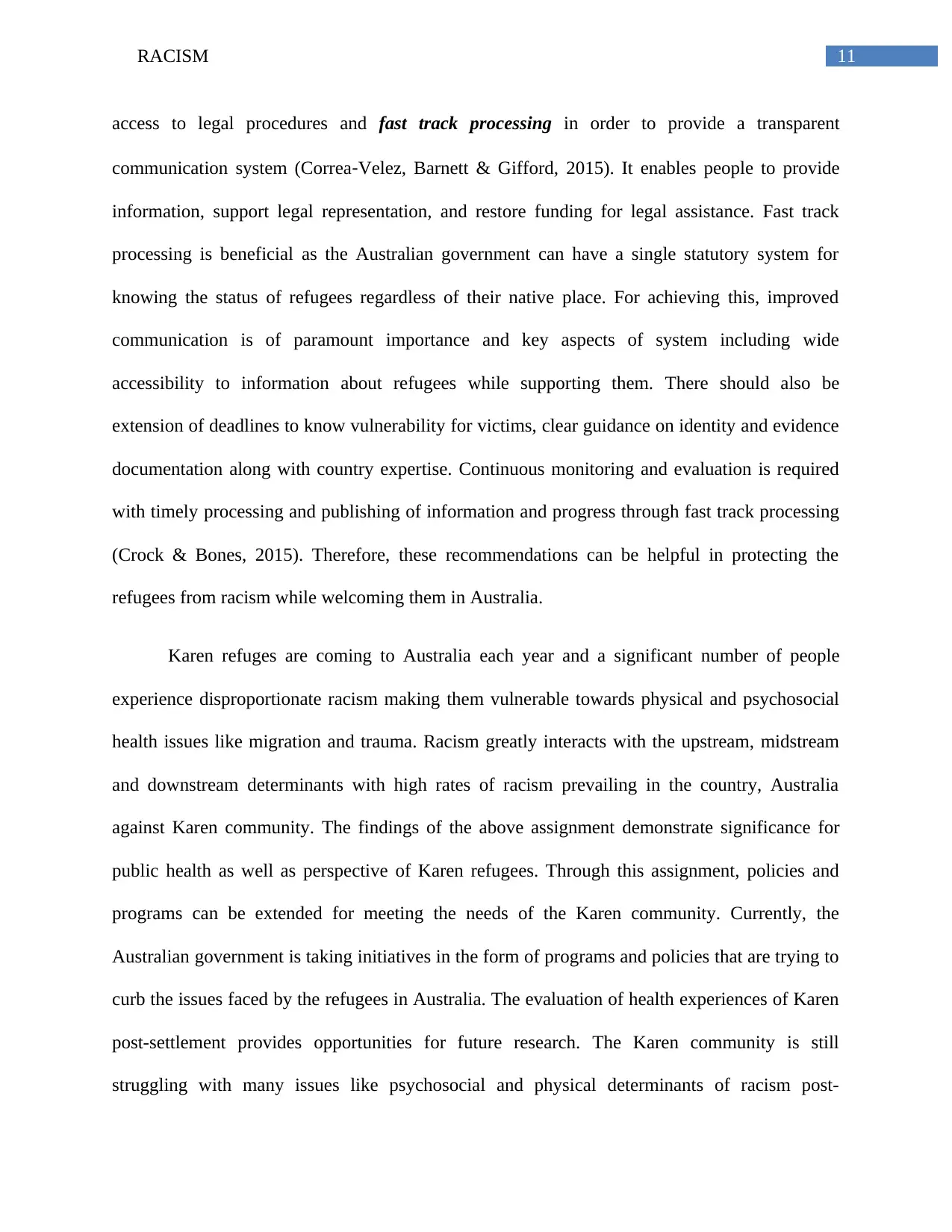
11RACISM
access to legal procedures and fast track processing in order to provide a transparent
communication system (Correa‐Velez, Barnett & Gifford, 2015). It enables people to provide
information, support legal representation, and restore funding for legal assistance. Fast track
processing is beneficial as the Australian government can have a single statutory system for
knowing the status of refugees regardless of their native place. For achieving this, improved
communication is of paramount importance and key aspects of system including wide
accessibility to information about refugees while supporting them. There should also be
extension of deadlines to know vulnerability for victims, clear guidance on identity and evidence
documentation along with country expertise. Continuous monitoring and evaluation is required
with timely processing and publishing of information and progress through fast track processing
(Crock & Bones, 2015). Therefore, these recommendations can be helpful in protecting the
refugees from racism while welcoming them in Australia.
Karen refuges are coming to Australia each year and a significant number of people
experience disproportionate racism making them vulnerable towards physical and psychosocial
health issues like migration and trauma. Racism greatly interacts with the upstream, midstream
and downstream determinants with high rates of racism prevailing in the country, Australia
against Karen community. The findings of the above assignment demonstrate significance for
public health as well as perspective of Karen refugees. Through this assignment, policies and
programs can be extended for meeting the needs of the Karen community. Currently, the
Australian government is taking initiatives in the form of programs and policies that are trying to
curb the issues faced by the refugees in Australia. The evaluation of health experiences of Karen
post-settlement provides opportunities for future research. The Karen community is still
struggling with many issues like psychosocial and physical determinants of racism post-
access to legal procedures and fast track processing in order to provide a transparent
communication system (Correa‐Velez, Barnett & Gifford, 2015). It enables people to provide
information, support legal representation, and restore funding for legal assistance. Fast track
processing is beneficial as the Australian government can have a single statutory system for
knowing the status of refugees regardless of their native place. For achieving this, improved
communication is of paramount importance and key aspects of system including wide
accessibility to information about refugees while supporting them. There should also be
extension of deadlines to know vulnerability for victims, clear guidance on identity and evidence
documentation along with country expertise. Continuous monitoring and evaluation is required
with timely processing and publishing of information and progress through fast track processing
(Crock & Bones, 2015). Therefore, these recommendations can be helpful in protecting the
refugees from racism while welcoming them in Australia.
Karen refuges are coming to Australia each year and a significant number of people
experience disproportionate racism making them vulnerable towards physical and psychosocial
health issues like migration and trauma. Racism greatly interacts with the upstream, midstream
and downstream determinants with high rates of racism prevailing in the country, Australia
against Karen community. The findings of the above assignment demonstrate significance for
public health as well as perspective of Karen refugees. Through this assignment, policies and
programs can be extended for meeting the needs of the Karen community. Currently, the
Australian government is taking initiatives in the form of programs and policies that are trying to
curb the issues faced by the refugees in Australia. The evaluation of health experiences of Karen
post-settlement provides opportunities for future research. The Karen community is still
struggling with many issues like psychosocial and physical determinants of racism post-
⊘ This is a preview!⊘
Do you want full access?
Subscribe today to unlock all pages.

Trusted by 1+ million students worldwide
1 out of 16
Related Documents
Your All-in-One AI-Powered Toolkit for Academic Success.
+13062052269
info@desklib.com
Available 24*7 on WhatsApp / Email
![[object Object]](/_next/static/media/star-bottom.7253800d.svg)
Unlock your academic potential
Copyright © 2020–2026 A2Z Services. All Rights Reserved. Developed and managed by ZUCOL.





